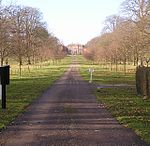Kerne Bridge
Bridges across the River WyeUse British English from July 2017Villages in Herefordshire
Kerne Bridge is a hamlet in south Herefordshire, England, about 3.5 miles (6 km) south of the market town of Ross-on-Wye on the B4234 Ross-on-Wye to Coleford road. Situated on the left bank of the River Wye, it takes its modern name from the nineteenth century bridge over the river. It was once a significant stop on the now disused and abandoned Monmouth to Ross-on-Wye railway, and is now known for a popular canoe-launching site. It marks the northern start of the Upper Wye Gorge and is situated in the heart of the Wye Valley Area of Outstanding Natural Beauty.
Excerpt from the Wikipedia article Kerne Bridge (License: CC BY-SA 3.0, Authors).Kerne Bridge
B4234,
Geographical coordinates (GPS) Address Nearby Places Show on map
Geographical coordinates (GPS)
| Latitude | Longitude |
|---|---|
| N 51.868 ° | E -2.60849 ° |
Address
B4234
HR9 5QT
England, United Kingdom
Open on Google Maps








